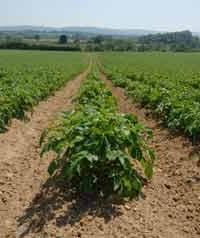An increase in the potato crop in agricultural enterprises implies, inter alia, a strenuous struggle with weeds. Weeds are much more unpretentious to growth factors than cultivated plants, so potatoes without human help will always lose to them the struggle for living space, nutrients, water and light.
However, the troubles for farmers do not end with serious obstacles in harvesting, reducing the commercial and seed qualities of potato tubers. Many of the weeds form a kind of incubator, where insect pests and various pathogens of plant diseases feel at ease. And the fact that clogged potato plantings are poorly ventilated greatly increases the risk of its defeat by the scourge of all nightshade ones - late blight. Therefore, where potatoes are not treated with herbicides, their losses can reach three quarters of the planned harvest.

Opponents of the use of chemicals as an argument cite the fact that potatoes are a row crop, which means that repeated intensive machining can be used against weeds. However, its flip side is the constant risk of damaging the tops and root system of potatoes, the transmission of a viral infection, and the drying of the soil.
It follows that the best way to
control weeds is with herbicides for potatoes, combined with machine tillage.
The dose of herbicides used depends on the mechanical composition of the soil and the content of humus in it. Heavy soil binds part of the drugs, so their dose is approaching the maximum permissible. In the lightest soils, it is recommended that doses be made, a quarter less than optimal.
A feature of the development of perennial weeds is that with the onset of autumn, the nutrients in them move from the leaves to the root system. As a result, they become more susceptible to herbicides that penetrate
plant tissues through stomata of leaves.
Herbicides for potatoes are applied at a temperature of +15 ... + 25 degrees. The effectiveness of the drugs is reduced by a lower temperature or precipitated 4-8 hours after the treatment of precipitation. 2-3 weeks after spraying, complete death of weeds occurs.
When using herbicides, it is necessary that:
- tubers were planted in ridges to the optimum depth so that the soil preparations did not reach the zone of potato sprouts;
- ridges well settled;
- the soil had a loose, lumpy structure and was moist so that the herbicides were evenly distributed and effectively "earned".
The use of herbicides on potatoes is not recommended if the tubers are finely planted, affected by frost, diseases, pests, and also if these
potato varieties show high sensitivity to herbicides, reacting to them with a delay in growth and development, anomalies in the leaf apparatus and tubers.
Potato herbicides are mainly distributed on sown areas using sprayers mounted on ground trailers or on agricultural aircraft. For the most part, these drugs are classified as medium and low toxic chemicals, however, when working with herbicides, the same safety rules must be followed as when working with pesticides.
In conclusion, it is worth emphasizing that potato herbicides are a chemical method of suppressing weeds, the use of which is justified if other methods have not reduced the weediness of crops to a safe level.